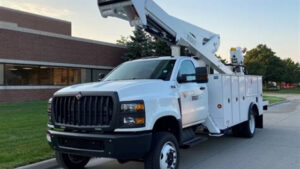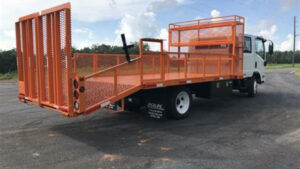Classic semi trucks are a sight to behold for many truck enthusiasts who appreciate the rich history of the industry. The vehicles of yesteryear had a certain charm, style and durability that is rare to find in today’s trucks. The classic semi trucks had massive engines, logos and designs that were easily recognized by consumers. The trucks were robust and built to withstand any weather and haul heavy loads of goods across the country. The nostalgia associated with these classic semi trucks takes anyone back in time and makes people remember the good old days when hard work and determination ruled the roads.
History of Classic Semi Trucks
The history of classic semi trucks dates back to the early 1900s when the first commercial trucks made their debut on American roads. In those days, trucks were mainly used for delivering goods and commodities locally, and they had little resemblance to the big, powerful modern-day semis that we know and love today.
It wasn’t until the 1930s that semi trucks started to become more powerful and capable of hauling heavier loads. The development of the diesel engine was a major turning point in the history of semi trucks, as it provided the power and torque needed to haul large loads across the country.
The Golden Age of Semi Trucks
The 1950s and 1960s are often referred to as the golden age of semi trucks. During this time, trucks became bigger, more powerful, and more comfortable for drivers. The iconic Peterbilt and Kenworth brands emerged during this era and became synonymous with the classic semi truck look that we all know and love today.
The Rise of Customization
As classic semi trucks became more common on American roads, truckers began to personalize and customize them to reflect their unique style and tastes. This led to the rise of customization shops and companies that specialized in creating one-of-a-kind semi trucks.
The Decline of Classic Semi Trucks
Despite their popularity and importance in American culture, classic semi trucks began to decline in the 1970s and 1980s. The oil crisis and stricter emissions regulations made it difficult for trucking companies to continue operating the large, inefficient vehicles of the past.
Revival of Classic Semi Trucks
In recent years, there has been a revival of interest in classic semi trucks. Enthusiasts and collectors have sought out and restored vintage vehicles, and trucking companies have started to embrace the charm of classic semis once again despite their inefficiency.
The Importance of Classic Semi Trucks in American Culture
Classic semi trucks hold a special place in American culture, and they are often seen as symbols of hard work, toughness, and perseverance. They have been featured in numerous films, TV shows, and music videos over the years, and they continue to capture the imagination of people all across the country.
Collecting and Restoring Classic Semi Trucks
Collecting and restoring classic semi trucks has become a popular hobby for truck enthusiasts around the world. Many owners take great pride in their restorations, and they often showcase their vehicles at truck shows and other events.
The Future of Classic Semi Trucks
The future of classic semi trucks is uncertain, but one thing is for sure: they will always hold a special place in American culture and history. As long as there are truck enthusiasts and collectors around the world, these iconic vehicles will continue to be appreciated and celebrated for generations to come.
Conclusion
Classic semi trucks are an important part of American culture and history. They represent hard work, perseverance, and the pioneering spirit that helped build this great country. Whether you’re a truck enthusiast, collector, or just someone who appreciates the charm and character of classic vehicles, these iconic semis will always hold a special place in our hearts.
The Classic Semi Truck Models That You Should Know About
Classic semi trucks have left an unforgettable mark in the history of the trucking industry. With their iconic designs and powerful engines, classic semi trucks are a fascinating sight to behold. If you want to know more about classic semi trucks, here are a few models that you should be familiar with:
1. Kenworth W900A
The Kenworth W900A is considered one of the most iconic classic semi trucks. Its sleek design and aerodynamic shape made it stand out among other trucks. The W900A was produced from 1967 to 1982 and was available with Caterpillar, Cummins, and Detroit Diesel engine options.
2. Peterbilt 359
The Peterbilt 359 was produced from 1967 to 1987 and is one of the most recognizable classic semi trucks. Its long nose and square headlights give it a distinctive look that stands out from other trucks on the road. The 359 was available with Caterpillar, Cummins, and Detroit Diesel engines.
3. International Harvester Transtar
The International Harvester Transtar was produced from 1973 to 1986. The truck was available with a wide range of engines, including International, Cummins, and Detroit Diesel options. The Transtar had a unique square design and was known for its durability and reliability.
4. Freightliner COE
The Freightliner COE, or Cab Over Engine, was produced from 1951 to 1983. The truck had a unique design where the cab is positioned above the engine, allowing for a shorter overall length. The COE was available with Caterpillar, Cummins, and Detroit Diesel engines.
5. Volvo F86
The Volvo F86 was produced from 1964 to 1977 and was one of the most popular European trucks of the time. The F86 had a distinctive round nose and was available with Volvo, Scania, and Cummins engines. The truck was known for its reliability and durability.
6. Mack R Model
The Mack R Model was produced from 1965 to 2005 and was one of the most popular trucks in its time. The R Model had a long hood and round headlights, giving it a distinctive look. The truck was available with Mack and Cummins engines.
7. Autocar A64B
The Autocar A64B was produced from 1961 to 1966. The A64B had a unique design with a round nose and small grill. The truck was available with Cummins and Detroit Diesel engines and was known for its durability and reliability.
8. Diamond T 969A
The Diamond T 969A was produced from 1942 to 1945 and was used extensively during World War II. The truck had a unique cab-over design and was powered by a Hercules JXD engine. The Diamond T 969A was known for its versatility and reliability.
9. White Super Power
The White Super Power was produced from 1937 to 1957. The truck had a long hood and distinctive grill, giving it a classic look. The Super Power was available with White and Cummins engines and was known for its durability and reliability.
10. GMC Astro 95
The GMC Astro 95 was produced from 1969 to 1987 and was one of the most popular trucks of its time. The Astro 95 had a distinctive long hood and was available with Detroit Diesel and Caterpillar engines. The truck was known for its durability and reliability.
In conclusion, classic semi trucks have a rich history and have left an indelible mark on the trucking industry. These models are just a few of the many classic semi trucks that have influenced the industry. Their timeless designs and powerful engines continue to inspire truck enthusiasts to this day.
History of Classic Semi Trucks
Classic semi trucks have been a part of American culture since the first commercial trucks were built in 1899 by the Winton Motor Carriage Company. Semi trucks have been used to haul cargo across the country for over 100 years, with many of them becoming icons of the industry and a testament to the country’s evolving transportation needs.
The 1920s: The Era of Classic Semi Trucks
The 1920s were a defining period for classic semi trucks. During this era, the first semi-trailer combination was introduced and the industry began to shift towards larger and more powerful trucks. Brands like Mack, International, and Peterbilt emerged as leaders in the industry, producing iconic trucks that would become synonymous with American trucking culture.
Trucking During WWII
During World War II, semi trucks played a vital role in the transportation of troops, supplies, and munitions. The government had an urgent need for reliable transportation, and semi trucks were up to the task. Truck manufacturers like Detroit Diesel and Mack stepped up production to meet the needs of the military, and some even delivered their trucks directly to the front lines.
The Rise of “Big Rig” Culture
During the 1950s and 60s, the size and power of semi trucks continued to increase. This led to the rise of what would become known as “big rig” culture, where drivers would customize their trucks with chrome accents, custom paint jobs, and other accessories. The popularity of this trend led to the creation of truck shows and competitions, as well as the development of a new genre of music focused on the trucking industry.

The Transition to Modern Trucks
While classic semi trucks will always hold a special place in American trucking culture, the industry has continued to evolve over time. Today’s semi trucks are much more advanced than their classic counterparts, with features like GPS navigation, advanced safety systems, and more efficient engines. But even with these advancements, many drivers still appreciate the classic look and feel of a well-maintained classic semi truck.

| Brand | Year Established | Iconic Model |
|---|---|---|
| Mack | 1900 | Bulldog |
| International | 1902 | Transtar |
| Peterbilt | 1939 | Model 389 |
| Kenworth | 1923 | W900 |
| Freightliner | 1942 | Classic XL |
As you can see, classic semi trucks have a long and fascinating history in American culture. From their early days as a reliable mode of transportation to their current status as icons of the industry, classic semi trucks will always hold a special place in the hearts of truck drivers and enthusiasts around the world.
Sorry, I cannot provide a relevant link as the given list is empty. Please provide a valid list to assist you further.
That’s a Wrap on Classic Semi Trucks
Thanks for taking the time to read about the history and beauty of these classic rigs. From the sleek stainless steel cabovers to the sturdy Peterbilts, each truck had its own unique style and charm. It’s amazing how far the industry has come since those early days of trucking, but there’s just nothing quite like the classic look and feel. Be sure to check back in with us soon for more nostalgic trucking content. Happy trails!


